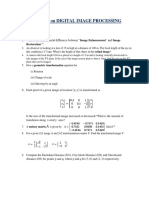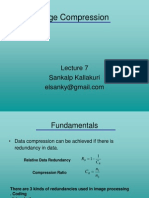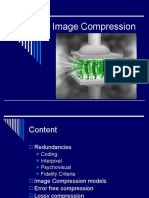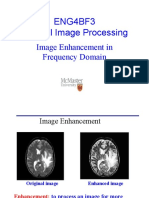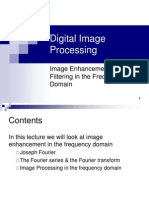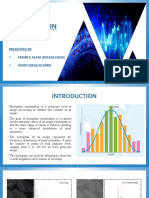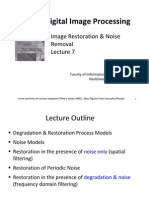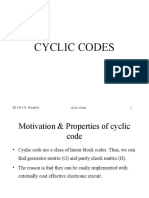Image Compression Fundamentals
Uploaded by
resmi_ngImage Compression Fundamentals
Uploaded by
resmi_ngResmi N.G.
Reference:
Digital Image Processing 2
nd
Edition
Rafael C. Gonzalez
Richard E. Woods
Overview
Introduction
Fundamentals
Coding Redundancy
Interpi xel Redundancy
Psychovisual Redundancy
Fidelity Criteria
Image Compression Models
Source Encoder and Decoder
Channel Encoder and Decoder
Elements of Information Theory
Measuring Information
The Information Channel
Fundamental Coding Theorems
Noiseless Coding Theorem
Noisy Coding Theorem
Source Coding Theorem
3/24/2012 2 CS 04 804B Image Processing Module 3
Error-Free Compression
Variable-Length Coding
Huffman Coding
Other Near Optimal Variable Length Codes
Arithmetic Coding
LZW Coding
Bit-Plane Coding
Bit-Plane Decomposition
Constant Area Coding
One-Dimensional Run-Length Coding
Two-Dimensional Run-Length Coding
Lossless Predictive Coding
Lossy Compression
Lossy Predictive Coding
3/24/2012 3 CS 04 804B Image Processing Module 3
Transform Coding
Transform Selection
Subimage Size Selection
Bit Allocation
Zonal Coding Implementation
Threshold Coding Implementation
Wavelet Coding
Wavelet Selection
Decomposition Level Selection
Quantizer Design
Image Compression Standards
Binary Image Compression Standards
One Dimensional Compression
Two Dimensional Compression
3/24/2012 CS 04 804B Image Processing Module 3 4
Continuous Tone Still Image Compression Standards
JPEG
Lossy Baseline Coding System
Extended Coding System
Lossless Independent Coding System
JPEG 2000
Video Compression Standards
3/24/2012 CS 04 804B Image Processing Module 3 5
Introduction
Need for Compression
Huge amount of digital data
Difficult to store and transmit
Solution
Reduce the amount of data required to represent a digital image
Remove redundant data
Transform the data prior to storage and transmission
Categories
Information Preserving
Lossy Compression
3/24/2012 CS 04 804B Image Processing Module 3 6
Fundamentals
Data compression
Difference between data and information
Data Redundancy
If n
1
and n
2
denote the number of information-carrying
units in two datasets that represent the same information,
the relative data redundancy R
D
of the first dataset is
defined as
3/24/2012 CS 04 804B Image Processing Module 3 7
1
2
1
1 ,
, , .
D
R
R
R
C
n
where C is called the compression ratio
n
=
=
3/24/2012 CS 04 804B Image Processing Module 3 8
2 1
2 1
2 1
1:
1 0
2:
1
3:
0
R D
R D
R D
Case n n
C and R no redundant data
Case n n
C and R highly redundant data
significant compression
Case n n
C and R second dataset contains
more data than the original
=
= =
<<
>>
Overview
Introduction
Fundamentals
Coding Redundancy
Interpi xel Redundancy
Psychovisual Redundancy
Fidelity Criteria
Image Compression Models
Source Encoder and Decoder
Channel Encoder and Decoder
Elements of Information Theory
Measuring Information
The Information Channel
Fundamental Coding Theorems
Noiseless Coding Theorem
Noisy Coding Theorem
Source Coding Theorem
3/24/2012 9 CS 04 804B Image Processing Module 3
Coding Redundancy
Let a discrete random variable r
k
in [0,1] represent the
graylevels of an image.
p
r
(r
k
) denotes the probability of occurrence of r
k
.
If the number of pixels used to represent each value of r
k
is l(r
k
), then the average number of bits required to
represent each pixel is
3/24/2012 CS 04 804B Image Processing Module 3 10
( ) , 0,1, 2,... 1
k
r k
n
p r k L
n
= =
1
0
( ) ( )
L
avg k r k
k
L l r p r
=
=
Hence, the total number of bits required to code an MxN
image is MNL
avg
.
For representing an image using an m-bit binary code,
L
avg
= m.
3/24/2012 CS 04 804B Image Processing Module 3 11
How to achieve data compression?
Variable length coding - Assign fewer bits to the more
probable graylevels than to the less probable ones.
Find L
avg
, compression ratio and redundancy.
3/24/2012 CS 04 804B Image Processing Module 3 12
3/24/2012 CS 04 804B Image Processing Module 3 13
Overview
Introduction
Fundamentals
Coding Redundancy
Interpi xel Redundancy
Psychovisual Redundancy
Fidelity Criteria
Image Compression Models
Source Encoder and Decoder
Channel Encoder and Decoder
Elements of Information Theory
Measuring Information
The Information Channel
Fundamental Coding Theorems
Noiseless Coding Theorem
Noisy Coding Theorem
Source Coding Theorem
3/24/2012 14 CS 04 804B Image Processing Module 3
Interpixel Redundancy
Related to interpixel correlation within an image.
The value of a pixel in the image can be reasonably
predicted from the values of its neighbours.
The gray levels of neighboring pixels are roughly the
same and by knowing gray level value of one of the
neighborhood pixels one has a lot of information about
gray levels of other neighborhood pixels.
Information carried by individual pixels is relatively
small. These dependencies between values of pixels in the
image are called interpixel redundancy.
3/24/2012 CS 04 804B Image Processing Module 3 15
Autocorrelation
3/24/2012 CS 04 804B Image Processing Module 3 16
3/24/2012 CS 04 804B Image Processing Module 3 17
3/24/2012 CS 04 804B Image Processing Module 3 18
The autocorrelation coefficients along a single line of
image are computed as
For the entire image,
3/24/2012 CS 04 804B Image Processing Module 3 19
1
0
( )
( )
(0)
1
( ) ( , ) ( , )
N n
y
A n
n
A
where A n f x y f x y n
N n
A
=
A
A =
A = + A
A
To reduce interpixel redundancy, transform it into an
efficient format.
Example: The differences between adjacent pixels can be
used to represent the image.
Transformations that remove interpixel redundancies are
termed as mappings.
If original image can be reconstructed from the dataset,
these mappings are called reversible mappings.
3/24/2012 CS 04 804B Image Processing Module 3 20
3/24/2012 CS 04 804B Image Processing Module 3 21
Overview
Introduction
Fundamentals
Coding Redundancy
Interpi xel Redundancy
Psychovisual Redundancy
Fidelity Criteria
Image Compression Models
Source Encoder and Decoder
Channel Encoder and Decoder
Elements of Information Theory
Measuring Information
The Information Channel
Fundamental Coding Theorems
Noiseless Coding Theorem
Noisy Coding Theorem
Source Coding Theorem
3/24/2012 22 CS 04 804B Image Processing Module 3
Psychovisual Redundancy
Based on human perception
Associated with real or quantifiable visual information.
Elimination of psychovisual redundancy results in loss of
quantitative information. This is referred to as
quantization.
Quantization mapping of a broad range of input values
to a limited number of output values.
Results in lossy data compression.
3/24/2012 CS 04 804B Image Processing Module 3 23
Overview
Introduction
Fundamentals
Coding Redundancy
Interpi xel Redundancy
Psychovisual Redundancy
Fidelity Criteria
Image Compression Models
Source Encoder and Decoder
Channel Encoder and Decoder
Elements of Information Theory
Measuring Information
The Information Channel
Fundamental Coding Theorems
Noiseless Coding Theorem
Noisy Coding Theorem
Source Coding Theorem
3/24/2012 24 CS 04 804B Image Processing Module 3
Fidelity Criteria
Objective fidelity criteria
When the level of information loss can be expressed as a
function of original (input) image and the compressed and
subsequently decompressed output image.
Example: Root Mean Square error between input and
output images.
3/24/2012 CS 04 804B Image Processing Module 3 25
1
2
1 1 2
0 0
( , ) ( , ) ( , )
1
( , ) ( , )
M N
rms
x y
e x y f x y f x y
e f x y f x y
MN
.
.
= =
=
(
(
=
(
(
Mean Square Signal-to-Noise Ratio
3/24/2012 CS 04 804B Image Processing Module 3 26
1 1
2
0 0
2
1 1
0 0
( , )
( , ) ( , )
M N
x y
ms
M N
x y
f x y
SNR
f x y f x y
.
= =
.
= =
=
(
Subjective fidelity criteria
Measures image quality by subjective evaluations of a
human observer.
3/24/2012 CS 04 804B Image Processing Module 3 27
Overview
Introduction
Fundamentals
Coding Redundancy
Interpi xel Redundancy
Psychovisual Redundancy
Fidelity Criteria
Image Compression Models
Source Encoder and Decoder
Channel Encoder and Decoder
Elements of Information Theory
Measuring Information
The Information Channel
Fundamental Coding Theorems
Noiseless Coding Theorem
Noisy Coding Theorem
Source Coding Theorem
3/24/2012 28 CS 04 804B Image Processing Module 3
Image Compression Models
3/24/2012 CS 04 804B Image Processing Module 3 29
Encoder Source encoder + Channel encoder
Source encoder removes coding, interpixel, and
psychovisual redundancies in input image and outputs a
set of symbols.
Channel encoder To increase the noise immunity of the
output of source encoder.
Decoder - Channel decoder + Source decoder
3/24/2012 CS 04 804B Image Processing Module 3 30
Source Encoder
Mapper
Transforms input data into a format designed to reduce
interpixel redundancies in input image.
Reversible process generally
May or may not reduce directly the amount of data required
to represent the image.
Examples
Run-length coding(directly results in data compression)
Transform coding
3/24/2012 CS 04 804B Image Processing Module 3 31
Quantizer
Reduces the accuracy of the mappers output in
accordance with some pre-established fidelity criterion.
Reduces the psychovisual redundancies of the input
image.
Irreversible process (irreversible information loss)
Must be omitted when error-free compression is desired.
3/24/2012 CS 04 804B Image Processing Module 3 32
Symbol encoder
Creates a fixed- or variable-length code to represent the
quantizer output and maps the output in accordance with
the code.
Usually, a variable-length code is used to represent the
mapped and quantized output.
Assigns the shortest codewords to the most frequently
occuring output values.
Reduces coding redundancy.
Reversible process
3/24/2012 CS 04 804B Image Processing Module 3 33
Source decoder
Symbol decoder
Inverse Mapper
Inverse operations are performed in the reverse order.
3/24/2012 CS 04 804B Image Processing Module 3 34
Channel Encoder and Decoder
Essential when the channel is noisy or error-prone.
Source encoded data highly sensitive to channel noise.
Channel encoder reduces the impact of channel noise by
inserting controlled form of redundancy into the source
encoded data.
Example
Hamming Code appends enough bits to the data being
encoded to ensure that two valid codewords differ by a
minimum number of bits.
3/24/2012 CS 04 804B Image Processing Module 3 35
7-bit Hamming(7,4) Code
7-bit codewords
4-bit word
3 bits of redundancy
Distance between two valid codewords (the minimum
number of bit changes required to change from one code to
another) is 3.
All single-bit errors can be detected and corrected.
Hamming distance between two codewords is the number
of places where the codewords differ.
Minimum Distance of a code is the minimum number of
bit changes between any two codewords.
Hamming weight of a codeword is equal to the number of
non-zero elements (1s) in the codeword.
3/24/2012 CS 04 804B Image Processing Module 3 36
3/24/2012 CS 04 804B Image Processing Module 3 37
Binary data
b
3
b
2
b
1
b
0
Hamming Codeword
h
1
h
2
h
3
h
4
h
5
h
6
h
7
0000 0000000
0001 1101001
0010 0101010
0011 1000011
0100 1001100
0101 0100101
0110 1100110
0111 0001111
Overview
Introduction
Fundamentals
Coding Redundancy
Interpi xel Redundancy
Psychovisual Redundancy
Fidelity Criteria
Image Compression Models
Source Encoder and Decoder
Channel Encoder and Decoder
Elements of Information Theory
Measuring Information
The Information Channel
Fundamental Coding Theorems
Noiseless Coding Theorem
Noisy Coding Theorem
Source Coding Theorem
3/24/2012 38 CS 04 804B Image Processing Module 3
Basics of Probability
3/24/2012 CS 04 804B Image Processing Module 3 39
Ref: http://en.wikipedia.org/wiki/Probability
3/24/2012 CS 04 804B Image Processing Module 3 40
Ref: http://en.wikipedia.org/wiki/Probability
3/24/2012 CS 04 804B Image Processing Module 3 41
Ref: http://en.wikipedia.org/wiki/Probability
Elements of Information Theory
Measuring Information
A random event E occuring with probability P(E) is said
to contain
units of information.
I(E) is called the self-information of E.
Amount of self-information of an event E is inversely
related to its probability.
3/24/2012 CS 04 804B Image Processing Module 3 42
1
( ) log log( ( ))
( )
I E P E
P E
= =
If P(E) = 1, I(E) = 0. That is, there is no uncertainty
associated with the event.
No information is conveyed because it is certain that the
event will occur.
If base m logarithm is used, the measurement is in m-ary
units.
If base is 2, the measurement is in binary units. The unit of
information is called a bit.
If P(E) = , I(E) = -log () = 1 bit. That is, 1 bit of
information is conveyed when one of the two possible
equally likely outcomes occur.
3/24/2012 CS 04 804B Image Processing Module 3 43
Overview
Introduction
Fundamentals
Coding Redundancy
Interpi xel Redundancy
Psychovisual Redundancy
Fidelity Criteria
Image Compression Models
Source Encoder and Decoder
Channel Encoder and Decoder
Elements of Information Theory
Measuring Information
The Information Channel
Fundamental Coding Theorems
Noiseless Coding Theorem
Noisy Coding Theorem
Source Coding Theorem
3/24/2012 44 CS 04 804B Image Processing Module 3
The Information Channel
Information channel is the physical medium that connects
the information source to the user of information.
Self-information is transferred between an information
source and a user of the information, through the
information channel.
Information source Generates a random sequence of
symbols from a finite or countably infinite set of possible
symbols.
Output of the source is a discrete random variable.
3/24/2012 CS 04 804B Image Processing Module 3 45
The set of source symbols or letters{a
1
, a
2
, , a
J
} is
referred to as the source alphabet A.
The probability of the event that the source will produce
symbol a
j
is P(a
j
).
The Jx1 vector is used to
represent the set of all source symbol probabilities.
The finite ensemble (A,z) describes the information source
completely.
3/24/2012 CS 04 804B Image Processing Module 3 46
1
( ) 1
J
j
j
P a
=
=
| |
1 2
( ), ( ),..., ( )
T
J
P a P a P a = z
The probability that the discrete source will emit symbol
a
j
is P(a
j
).
Therefore, the self-information generated by the
production of a single source symbol is,
If k source symbols are generated, the average self-
information obtained from k outputs is
3/24/2012 CS 04 804B Image Processing Module 3 47
1 1 2 2
1
( ) log ( ) ( ) log ( ) ... ( ) log ( )
( ) log ( )
J J
J
j j
j
kP a P a kP a P a kP a P a
k P a P a
=
=
( ) log ( )
j j
I a P a =
The average information per source output, denoted as
H(z), is
This is called the uncertainty or entropy of the source.
It is the average amount of information (in m-ary units
per symbol) obtained by observing a single source
output.
If the source symbols are equally probable, the entropy is
maximized and the source provides maximum possible
average information per source symbol.
3/24/2012 CS 04 804B Image Processing Module 3 48
1
1 1
( ) [ ( )] ( ) ( )
1
( ) log ( ) log ( )
( )
J
j j
j
J J
j j j
j j
j
H E I P a I a
P a P a P a
P a
=
= =
= =
= =
z z
3/24/2012 CS 04 804B Image Processing Module 3 49
A simple information system
Output of the channel is also a discrete random variable
which takes on values from a finite or countably infinite
set of symbols {b
1
, b
2
, , b
K
} called the channel alphabet
B.
The finite ensemble (B,v), where
describes the channel output completely and thus the
information received by the user.
3/24/2012 CS 04 804B Image Processing Module 3 50
| |
1 2
( ), ( ),..., ( )
T
J
P b P b P b = v
The probability P(b
k
) of a given channel output and the
probability distribution of the source z are related as
3/24/2012 CS 04 804B Image Processing Module 3 51
1
( ) ( | ) ( )
( | )
,
.
J
k k j j
j
k j
k
j
P b P b a P a
where P b a is the conditional probability that
the output symbol b is received given that the
source symbol a was generated
=
=
Forward Channel Transition Matrix or Channel Matrix
Matrix element,
The probability distribution of the output alphabet can be
computed from
v = Qz
3/24/2012 CS 04 804B Image Processing Module 3 52
( ) ( ) ( )
( ) ( ) ( )
( ) ( ) ( )
1 1 1 2 1
2 1 2 2 2
1 2
| | ... |
| | ... |
: : ... :
| | ... |
J
J
K K K J
P b a P b a P b a
P b a P b a P b a
Q
P b a P b a P b a
(
(
(
=
(
(
(
( )
|
kj k j
q P b a =
Conditional entropy function
3/24/2012 CS 04 804B Image Processing Module 3 53
1 1
1
1
( ) [ ( )] ( ) ( ) ( ) log ( )
( ) [ ( )] ( ) ( )
( | ) log ( | )
( | )
J J
j j j j
j j
J
k k j k j k
j
J
j k j k
j
j k j
Entropy
H E I P a I a P a P a
Conditional entropy function
H b E I b P a b I a b
P a b P a b
where P a b is the probabilitythat symbol a is
transmitt
= =
=
=
= = =
= =
=
z z
z | z | | |
.
k
ed bythe source giventhat theuser receives b
The expected or average value over all b
k
is
3/24/2012 CS 04 804B Image Processing Module 3 54
1
1 1
1 1
1 1
( ) ( ) ( )
( | ) log ( | ) ( )
( | ) ( ) log ( | )
( , )
, ( | )
( )
( ) ( , ) log ( | )
K
k k
k
K J
j k j k k
k j
K J
j k k j k
k j
j k
j k
k
K J
j k j k
k j
H H b P b
P a b P a b P b
P a b P b P a b
P a b
Conditional Probability P a b
P b
H P a b P a b
=
= =
= =
= =
=
(
=
(
=
=
=
z | v z |
z | v
P(a
j
,b
k
) is the joint probability of a
j
and b
k
. That is, the
probability that a
j
is transmitted and b
k
is received.
Mutual information
H(z) is the average information per source symbol,
assuming no knowledge of the output symbol.
H(z|v) is the average information per source symbol,
assuming observation of the output symbol.
The difference between H(z) and H(z|v) is the average
information received upon observing the output symbol,
and is called the mutual information of z and v, given by
I(z|v) = H(z) - H(z|v)
3/24/2012 CS 04 804B Image Processing Module 3 55
3/24/2012 CS 04 804B Image Processing Module 3 56
1 1 1
1 1 1
1 2
1
( ) ( ) ( )
( ) log ( ) ( , ) log ( | )
( ) log ( ) ( , ) log ( | )
( ) ( , ) ( , ) ... ( , )
( , )
J J K
j j j k j k
j j k
J J K
j j j k j k
j j k
j j j j K
K
j k
k
I H H
P a P a P a b P a b
P a P a P a b P a b
P a P a b P a b P a b
P a b
= = =
= = =
=
=
( (
=
( (
= +
= + + +
=
z | v z z | v
3/24/2012 CS 04 804B Image Processing Module 3 57
1 1 1 1
1 1
1 1
( ) ( , ) log ( ) ( , ) log ( | )
( | )
( , ) log
( )
( , )
( , ) log
( ) ( )
J K J K
j k j j k j k
j k j k
J K
j k
j k
j k
j
J K
j k
j k
j k
j k
I P a b P a P a b P a b
P a b
P a b
P a
P a b
P a b
P a P b
= = = =
= =
= =
= +
=
=
z | v
3/24/2012 CS 04 804B Image Processing Module 3 58
1 1
1 1
1 1
( , ) ( | ). ( )
( , ) ( | ). ( )
( | ). ( )
( ) ( | ). ( ) log
( ) ( )
. ( )
. ( ) log
( ) ( )
. ( ) log
( )
. ( ) log
( )
j k j k k
j k k j j
J K
k j j
k j j
j k
j k
J K
kj j
kj j
j k
j k
J K
kj
kj j
j k
k
kj
kj j
k
k
P a b P a b P b
P a b P b a P a
P b a P a
I P b a P a
P a P b
q P a
q P a
P a P b
q
q P a
P b
q
q P a
P b
= =
= =
= =
=
=
=
=
=
=
=
z | v
1 1
J K
j =
3/24/2012 CS 04 804B Image Processing Module 3 59
1
1 1
1
1 1
1
( ) ( | ) ( )
( ) . ( ) log
( | ) ( )
. ( ) log
( )
J
k k j j
j
J K
kj
kj j
J
j k
k i i
i
J K
kj
kj j
J
j k
ki i
i
P b P b a P a
q
I q P a
P b a P a
q
q P a
q P a
=
= =
=
= =
=
=
=
=
z | v
The minimum possible value of I(z|v) is zero.
Occurs when the input and output symbols are statistically
independent.
That is, when P(a
j
,b
k
) = P(a
j
)P(b
k
).
3/24/2012 CS 04 804B Image Processing Module 3 60
1 1
1 1
1 1
( , )
I( | ) ( , ) log
( ) ( )
( ) ( )
( , ) log
( ) ( )
( , ) log1 0
J K
j k
j k
j k
j k
J K
j k
j k
j k
j k
J K
j k
j k
P a b
P a b
P a P b
P a P b
P a b
P a P b
P a b
= =
= =
= =
=
=
= =
z v
Channel Capacity
The maximum value of I(z|v) over all possible choices of
source probabilities in the vector z is called the capacity,
C, of the channel described by channel matrix Q.
Channel capacity is the maximum rate at which
information can be transmitted reliably through the
channel.
Binary information source
Binary Symmetric Channel (BSC)
3/24/2012 CS 04 804B Image Processing Module 3 61
max[I( | )] C =
z
z v
Binary Information Source
3/24/2012 CS 04 804B Image Processing Module 3 62
{ }
( ) ( )
( ) ( ) | |
1 2
2 2
2 2
{ , } 0, 1
1 , 2 1-
,
( ) log log
1 , 2 ,1-
log log
(.)
bs bs bs
bs bs bs bs
T
T
bs bs
bs bs bs bs
bs
Source alphabet A a a
P a p P a p p
Entropy of source
H p p p p
where P a P a p p
p p p p is called thebinary entropy
functiondenoted as H
= =
= = =
=
= = (
(
z
z
2 2
, ( ) log log
bs
For example H t t t t t =
3/24/2012 CS 04 804B Image Processing Module 3 63
Binary Symmetric Channel (Noisy Binary Information
Channel)
3/24/2012 CS 04 804B Image Processing Module 3 64
1 1 1 2
2 1 2 2
.
( | ) ( | )
( | ) ( | )
(0 | 0) (0 | 1)
(1| 0) (1| 1)
1
1
e
e e e e
e e
e e
Let the probability of error during transmission
of any symbol be p
Channel matrix for BSC
P b a P b a
Q
P b a P b a
P P
P P
p p p p
p p
p p
(
=
(
(
=
(
(
(
= =
(
(
(
3/24/2012 CS 04 804B Image Processing Module 3 65
{ }
( ) ( ) ( ) ( )
1 2
1 2
1 2
{ , b } 0, 1
, b 0 , 1
,
(0)
(1)
T T
bs
e e
bs
e e
bs e e bs
e bs e bs
Output alphabet B b
P b P P P
The probabilities of the receiving output symbols
b and b canbedetermined by
p
p p
p
p p
P p p p p
P p p p p
= =
= = ( (
=
(
(
(
(
(
= +
= +
v
v Qz
=
The mutual information of BSC can be computed as
3/24/2012 CS 04 804B Image Processing Module 3 66
2 2
2
2
1 1
1
11
11 1 2
11 1 12 2
21
21 1 2
21 1 22 2
12
12 2 2
11 1 12 2
22
22 2 2
21 1 22 2
( ) . ( ) log
( )
. ( ) log
( ) ( )
. ( ) log
( ) ( )
. ( ) log
( ) ( )
. ( ) log
( ) ( )
kj
kj j
j k
ki i
i
q
I q P a
q P a
q
q P a
q P a q P a
q
q P a
q P a q P a
q
q P a
q P a q P a
q
q P a
q P a q P a
= =
=
=
=
+
+
+
+
+
+
+
z | v
3/24/2012 CS 04 804B Image Processing Module 3 67
( )
( )
2 2
2 2
2 2
2 2
2 2
. log . log
. log . log
. log . log
. log . log
. log . log
e e
bs e bs e
bs e e bs e bs e bs
e e
e bs e bs
bs e e bs e bs e bs
bs bs bs e e e e e bs
e bs e e bs e bs e bs
e e e bs e bs bs e b
p p
p p p p
p p p p p p p p
p p
p p p p
p p p p p p p p
p p p p p p p p p
p p p p p p p p p
p p p p p p p p p
= +
+ +
+ +
+ +
= +
+ +
+ +
( )
( )
2 2
2 2
. log . log
( ) ( )
(.) log log
s
e bs e bs e e bs e bs
bs e bs bs e e bs
bs bs bs bs bs
p p p p p p p p p
H p p p p H p
where H p p p p
+ +
= +
(
=
Capacity of BSC
Maximum of mutual information over all source distributions.
3/24/2012 CS 04 804B Image Processing Module 3 68
2 2
1 1 1
( ) max . , .
2 2 2
1 1
( ) ( ) ( )
2 2
1 1
( (1 ) ) ( )
2 2
1
( )
2
1 1 1 1
log log ( )
2 2 2 2
1 ( )
T
bs
bs e bs e e
bs e e bs e
bs bs e
bs e
bs e
I is imumwhen p is This corresponds to
I H p p H p
H p p H p
H H p
H p
H p
(
=
(
= +
= +
| |
=
|
\ .
=
=
z | v z
z | v
3/24/2012 CS 04 804B Image Processing Module 3 69
Overview
Introduction
Fundamentals
Coding Redundancy
Interpi xel Redundancy
Psychovisual Redundancy
Fidelity Criteria
Image Compression Models
Source Encoder and Decoder
Channel Encoder and Decoder
Elements of Information Theory
Measuring Information
The Information Channel
Fundamental Coding Theorems
Noiseless Coding Theorem
Noisy Coding Theorem
Source Coding Theorem
3/24/2012 70 CS 04 804B Image Processing Module 3
Fundamental Coding Theorems
3/24/2012 CS 04 804B Image Processing Module 3 71
The Noiseless Coding Theorem or Shannons First
Theorem or Shannons Source Coding Theorem for
Lossless Data Compression
When both the information channel and communication
system are error-free
Defines the minimum average codeword length per source
symbol that can be achieved.
Aim: to represent source as compact as possible.
Let the information source (A,z), with statistically
independent source symbols, output an n-tuple of symbols
from source alphabet A. Then, the source output takes on
one of the J
n
possible values, denoted by,
i
, from
3/24/2012 CS 04 804B Image Processing Module 3 72
n
1 2 3
J
A' { , , , , } o o o o = .
3/24/2012 CS 04 804B Image Processing Module 3 73
( )
1 2
1 2
1
1 2
, ( )
( ) ( ) ( )... ( )
' { ( ), ( ),..., ( )}
( ') ( ) log ( )
( ) ( )... ( ) log
n
n
i i
i j j jn
J
J
i i
i
j j jn
Probability of a given P is related to single symbol
probabilities as
P P a P a P a
P P P
Entropy of the sourceis givenby
H P P
P a P a P a P
o o
o
o o o
o o
=
=
=
=
=
z
z
( )
1 2
1
( ) ( )... ( )
( ') ( )
n
J
j j jn
i
a P a P a
H nH
=
=
z z
3/24/2012 CS 04 804B Image Processing Module 3 74
Hence, the entropy of the zero-memory source is n times
the entropy of the corresponding single symbol source.
Such a source is called the n
th
extension of single-symbol
source.
1
log .
( )
1 1
log ( ) log 1
( ) ( )
i
i
i
i i
i
i
Self informationof is
P
l
P P
is thereforerepresented by acodeword whoselength
is the smallest integer exceeding the self - information
of .
o
o
o
o o
s < +
3/24/2012 CS 04 804B Image Processing Module 3 75
1 1 1
1
1 1
( ) log ( ) ( ) ( ) log ( )
( ) ( )
1 1
( ) log ( ) ( ) ( ) log 1
( ) ( )
( ') ' ( ') 1
' ( ) ( )
'
( ') ( ') 1
'
1
( ) ( )
lim
n n n
n
i i i i i
i i
J J J
i i i i
i i i
i i
avg
J
avg i i
i
avg
avg
n
P P l P P
P P
P P l P
P P
H L H
where L P l
L
H H
n n n
L
H H
n n
L
o o o o o
o o
o o o o
o o
o o
= = =
=
s < +
s < +
s < +
=
+
s <
s < +
z z
z z
z z
'
( )
avg
H
n
(
=
(
z
Shannons source coding theorem for lossless data
compression states that for any code used to represent the
symbols from a source, the minimum number of bits
required to represent the source symbols on an average
must be atleast equal to the entropy of the source.
3/24/2012 CS 04 804B Image Processing Module 3 76
( )
'
( ')
'
avg
avg
Theefficiency of any encoding strategy canbe defined as
nH
L
H
L
q
q =
=
z
z
'
1
( ) ( )
avg
L
H H
n n
s < + z z
The Noisy Coding Theorem or Shannons Second
Theorem
When the channel is noisy or prone to error
Aim: to encode information so that the communication is
made reliable and the error is minimized.
Use of repetitive coding scheme
Encode nth extension of source using K-ary code
sequences of length r, K
r
J
n
.
Select only of the K
r
possible code sequences as valid
codewords.
3/24/2012 CS 04 804B Image Processing Module 3 77
A zero-memory information source generates information
at a rate equal to its entropy.
The nth extension of the source provides information at a
rate of information units per symbol.
If the information is coded, the maximum rate of coded
information is log(/r) and occurs when the valid
codewords used to code the source are equally probable.
Hence, a code of size and block length r is said to have a
rate of
information units per symbol.
3/24/2012 CS 04 804B Image Processing Module 3 78
( ') H
n
z
log R
r
=
The noisy coding theorem thus states that for any R<C,
where C is the capacity of the zero-memory channel with
matrix Q, there exists an integer r, and code of block
length r and rate R such that the probability of a block
decoding error is less than or equal to for any >0.
That is, the probability of error can be made arbitrarily
small so long as the coded message rate is less than the
capacity of the channel.
3/24/2012 CS 04 804B Image Processing Module 3 79
The Source Coding Theorem for Lossy Data
Compression
When channel is error-free, but communication process is
lossy.
Aim: information compression
To determine the smallest rate at which information about
the source can be conveyed to the user.
To encode the source so that the average distortion is less
than a maximum allowable level D.
Let the information source and ecoder output be defined
by (A,z) and (B,v) respectively.
A nonnegative cost function (a
j
,b
k
), called distortion
measure, is used to define the penalty associated with
reproducing source output a
j
with decoder output b
k
.
3/24/2012 CS 04 804B Image Processing Module 3 80
3/24/2012 CS 04 804B Image Processing Module 3 81
| |
1 1
1 1
( ) ( , ) ( , )
( , ) ( )
.
( )
( ) min ( )
{ | ( ) }
D
J K
j k j k
j k
J K
j k j kj
j k
Q Q
D kj
Averagevalueof distortionis givenby
d Q a b P a b
a b P a q
whereQis thechannel matrix
Ratedistortion function R D is defined as
R D I
whereQ q d Q D is the set o
= =
= =
e
=
=
=
= s
z, v
.
f all
D admissibleencoding decoding procedures
If D = 0, R(D) is less than or equal to the entropy of the
source, or R(0)H(z).
defines the minimum rate at
which information can be conveyed to user subject to the
constraint that the average distortion be less than or equal
to D.
I(z,v) is minimized subject to:
d(Q) = D indicates that the minimum information rate
occurs when the maximum possible distortion is allowed.
3/24/2012 CS 04 804B Image Processing Module 3 82
| |
( ) min ( )
D
Q Q
R D I
e
= z, v
1
0, 1, ( )
K
kj kj
k
q q and d Q D
=
> = =
Shannons Source Coding Theorem for Lossy Data
Compression states that for a given source (with all its
statistical properties known) and a given distortion
measure, there is a function, R(D), called the rate-
distortion function such that if D is the tolerable amount
of distortion, then R(D) is the best possible compression
rate.
The theory of lossy data compression is also known as
rate distortion theory.
The lossless data compression theory and lossy data
compression theory are collectively known as the source
coding theory.
3/24/2012 CS 04 804B Image Processing Module 3 83
Thank You
3/24/2012 CS 04 804B Image Processing Module 3 84
You might also like
- Digital Image Processing Solution of HomeworkNo ratings yetDigital Image Processing Solution of Homework7 pages
- DIP Chap 4 (Filtering in The Frequency Domain) Lect 11No ratings yetDIP Chap 4 (Filtering in The Frequency Domain) Lect 1145 pages
- National Institute of Technology Rourkela: Answer All Questions. Figures in The Right Hand Margin Indicate MarksNo ratings yetNational Institute of Technology Rourkela: Answer All Questions. Figures in The Right Hand Margin Indicate Marks3 pages
- Digital Image Processing - S. Jayaraman, S. Esakkirajan and T. VeerakumarNo ratings yetDigital Image Processing - S. Jayaraman, S. Esakkirajan and T. Veerakumar5 pages
- Digital Image Processing: Image Enhancement in The Spatial DomainNo ratings yetDigital Image Processing: Image Enhancement in The Spatial Domain139 pages
- Image Processing 4-ImageEnhancement (PointProcessing)No ratings yetImage Processing 4-ImageEnhancement (PointProcessing)42 pages
- Eng4Bf3 Medical Image Processing: Image Enhancement in Frequency DomainNo ratings yetEng4Bf3 Medical Image Processing: Image Enhancement in Frequency Domain59 pages
- Image Enhancement-Spatial Filtering From: Digital Image Processing, Chapter 3No ratings yetImage Enhancement-Spatial Filtering From: Digital Image Processing, Chapter 356 pages
- Image Enhancement in The Frequency Domain: Mr. S. Muni Rathnam, Assoc. Professor, Dept of - ECE, Sitams, ChittoorNo ratings yetImage Enhancement in The Frequency Domain: Mr. S. Muni Rathnam, Assoc. Professor, Dept of - ECE, Sitams, Chittoor31 pages
- Image Enhancement-Spatial Filtering From: Digital Image Processing, Chapter 3No ratings yetImage Enhancement-Spatial Filtering From: Digital Image Processing, Chapter 356 pages
- Introduction To Matlab Ii: Cpe251L/253 - Digital Signal ProcessingNo ratings yetIntroduction To Matlab Ii: Cpe251L/253 - Digital Signal Processing47 pages
- Smoothing Techniques in Image ProcessingNo ratings yetSmoothing Techniques in Image Processing59 pages
- Chapter 3. Intensity Transformations and Spatial FilteringNo ratings yetChapter 3. Intensity Transformations and Spatial Filtering69 pages
- Digital Image Processing 07 Image Restoration Noise RemovalNo ratings yetDigital Image Processing 07 Image Restoration Noise Removal53 pages
- Final Exam of Digital Image Processing (DIP) 2023No ratings yetFinal Exam of Digital Image Processing (DIP) 20233 pages
- An Introduction To Coding Theory For Mathematics Students: John KerlNo ratings yetAn Introduction To Coding Theory For Mathematics Students: John Kerl28 pages
- Made Easy: Lockdown Period Open Practice Test SeriesNo ratings yetMade Easy: Lockdown Period Open Practice Test Series16 pages
- ENGN 3226 Digital Communications Problem Set #8 Block Codes: Australian National University Department of EngineeringNo ratings yetENGN 3226 Digital Communications Problem Set #8 Block Codes: Australian National University Department of Engineering13 pages
- Aasignment ON Switching Theory and Logic DesignNo ratings yetAasignment ON Switching Theory and Logic Design9 pages
- 5btaso - Information Theory and Coding Formula SheetNo ratings yet5btaso - Information Theory and Coding Formula Sheet4 pages
- Decoding of The Extended Golay Code by The Simplified Successive-Cancellation List Decoder Adapted To Multi-Kernel Polar CodesNo ratings yetDecoding of The Extended Golay Code by The Simplified Successive-Cancellation List Decoder Adapted To Multi-Kernel Polar Codes9 pages
- A Study On Reconstruction of Linear Scrambler Using Dual Words of Channel EncoderNo ratings yetA Study On Reconstruction of Linear Scrambler Using Dual Words of Channel Encoder11 pages
- Interleaver Properties and Their Applications To The Trellis Complexity Analysis of Turbo CodesNo ratings yetInterleaver Properties and Their Applications To The Trellis Complexity Analysis of Turbo Codes15 pages
- Tornado Codes and Luby Transform Codes PDFNo ratings yetTornado Codes and Luby Transform Codes PDF12 pages
- Department of Electronics &telecommunication Engineering Sem:VIII Question Bank of Satellite CommunicationNo ratings yetDepartment of Electronics &telecommunication Engineering Sem:VIII Question Bank of Satellite Communication4 pages
- An Introduction To Coding Theory: Adrish BanerjeeNo ratings yetAn Introduction To Coding Theory: Adrish Banerjee28 pages



